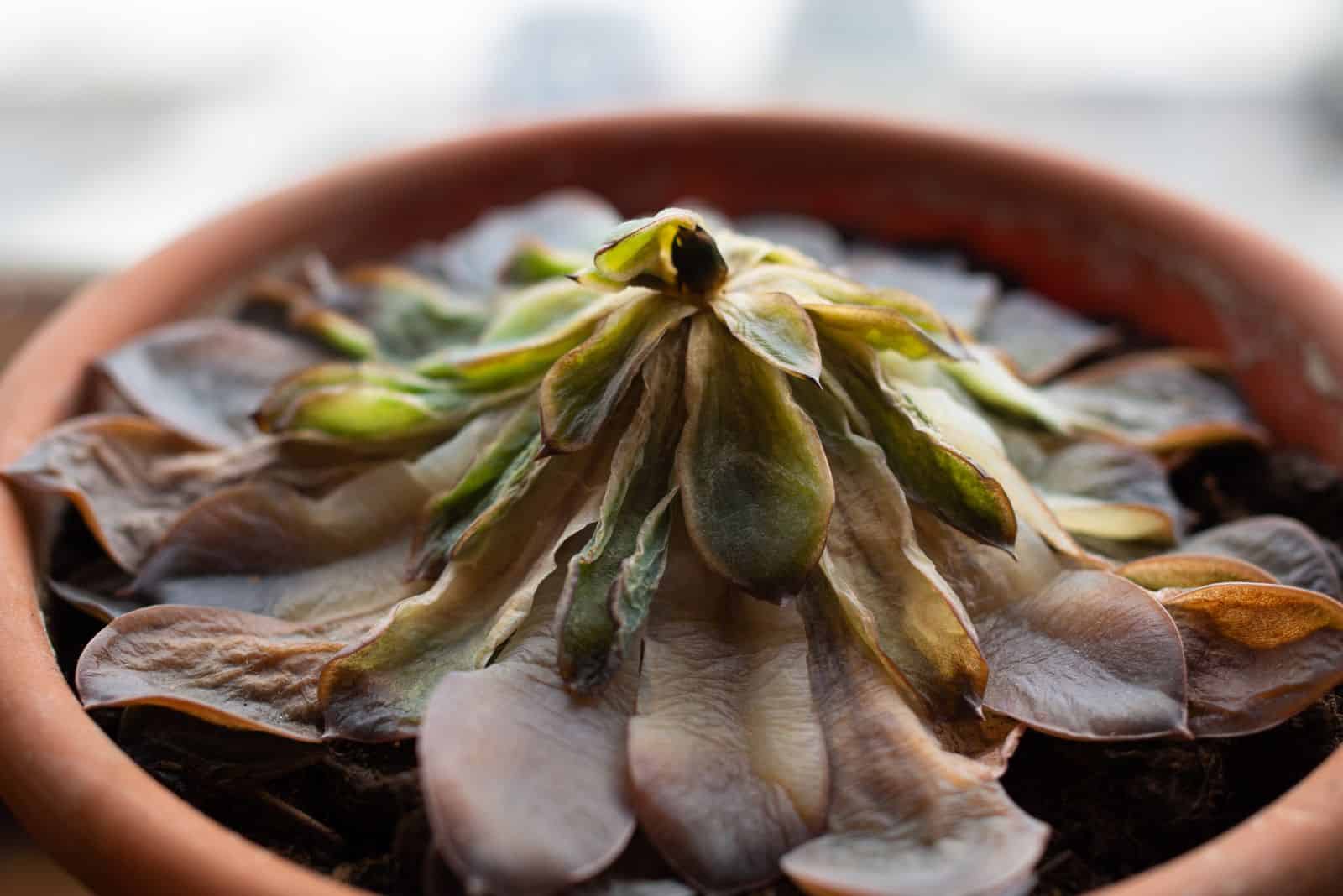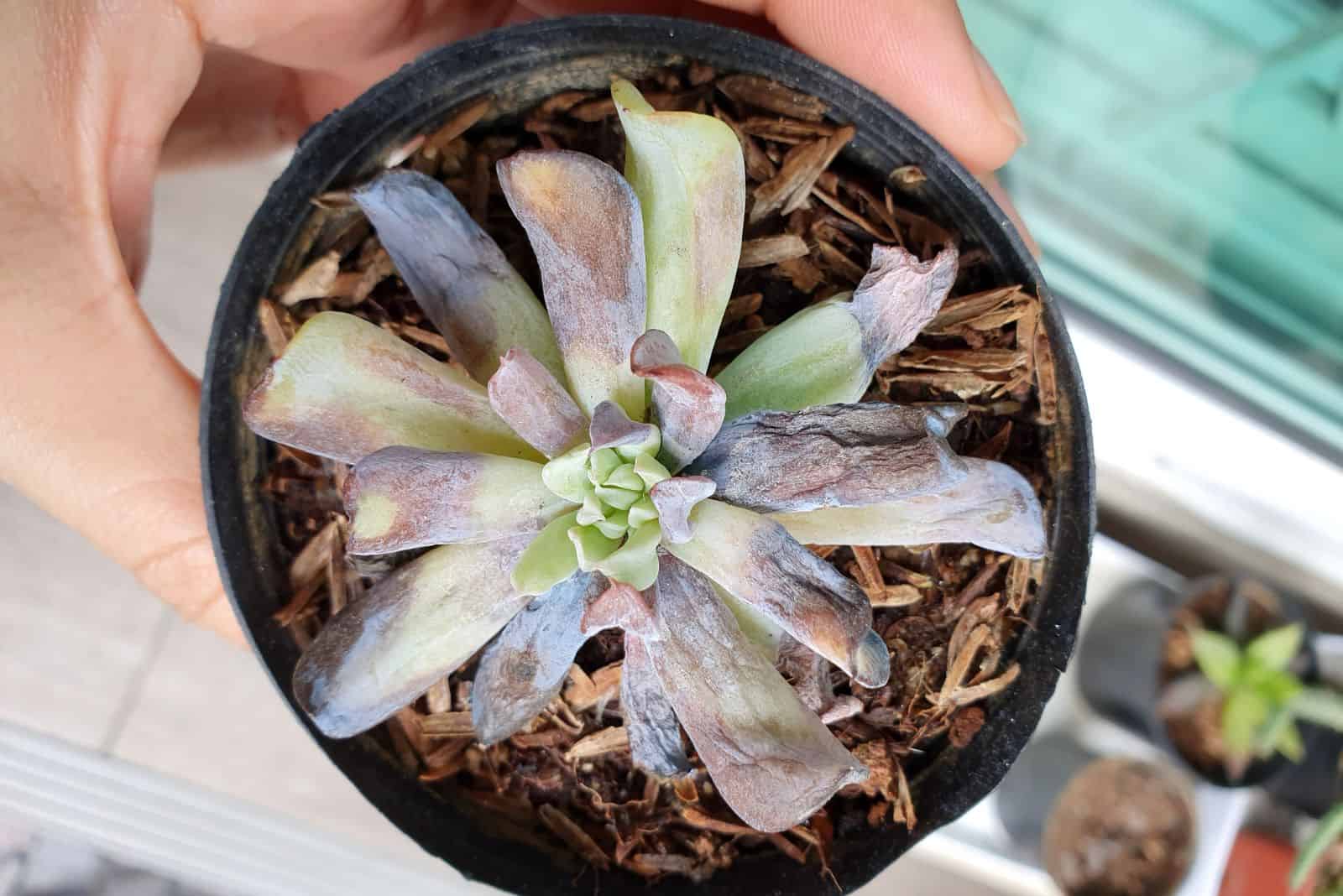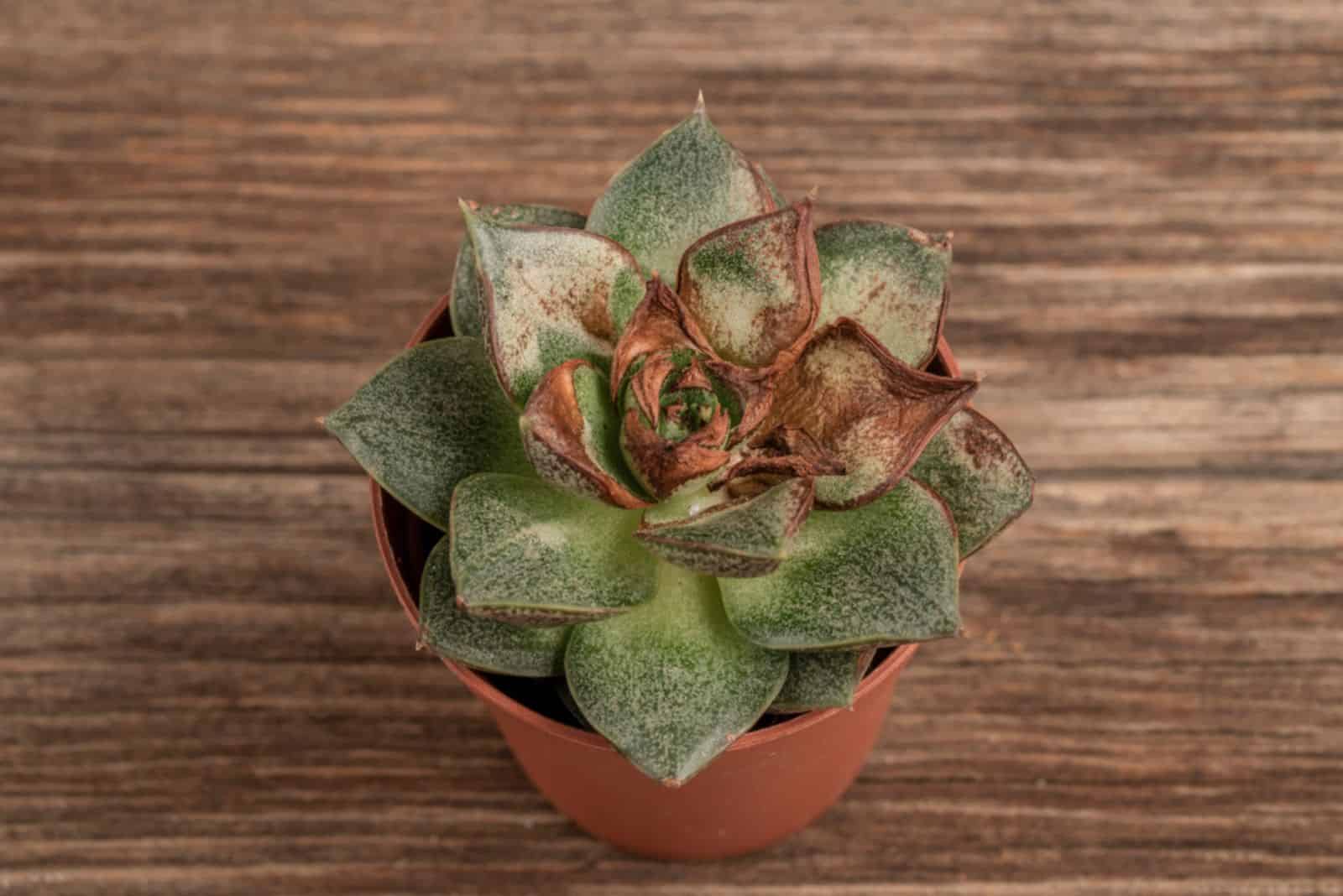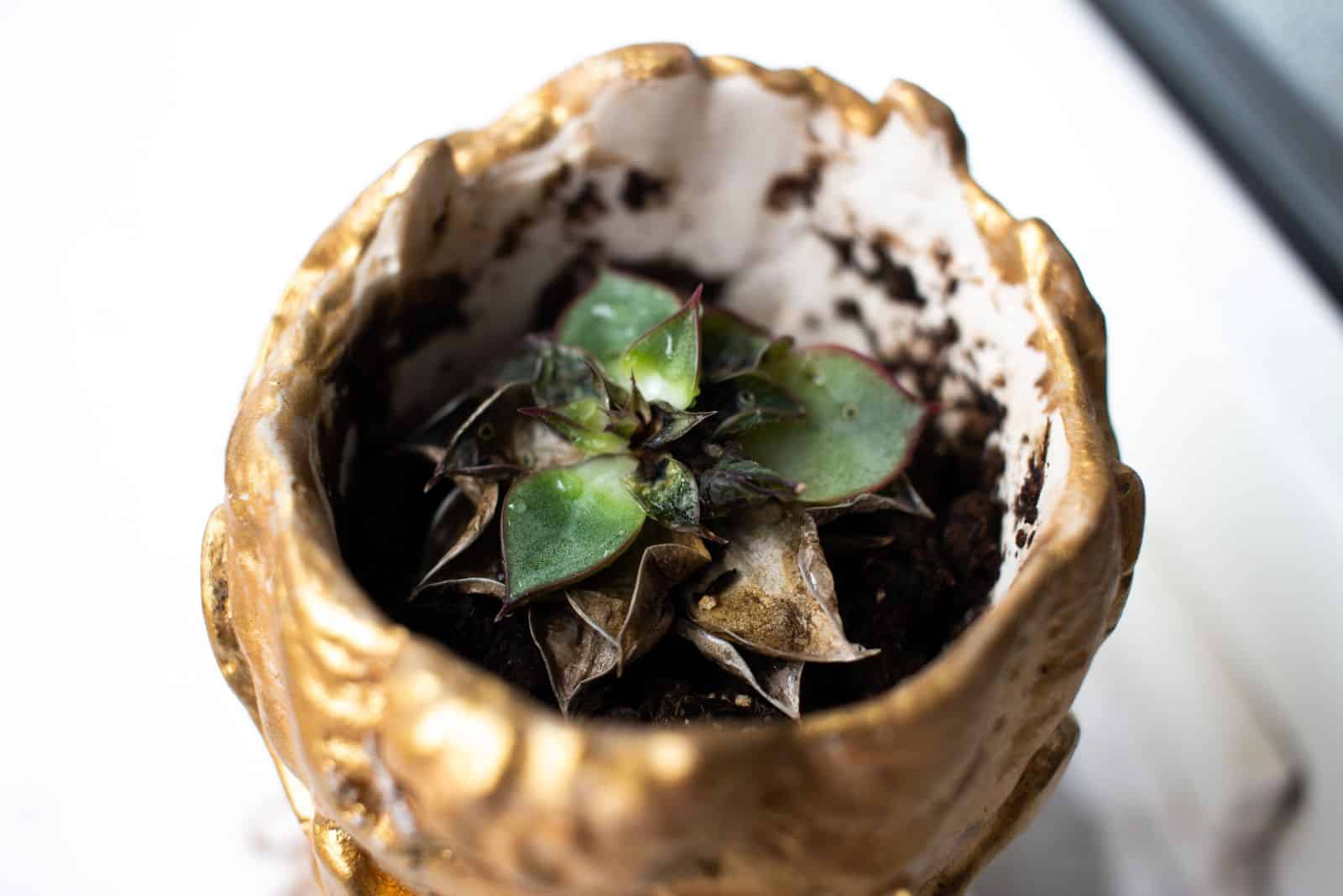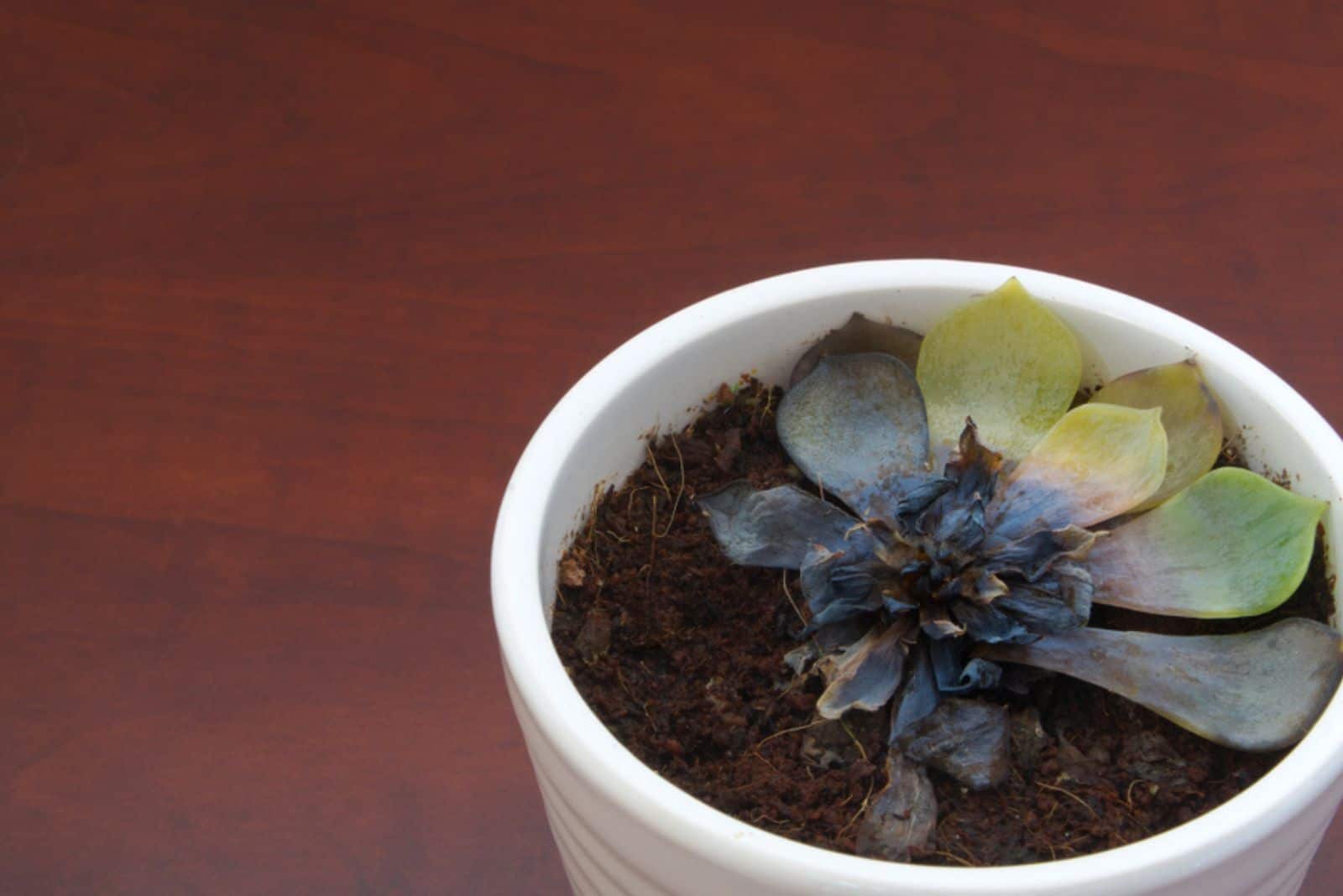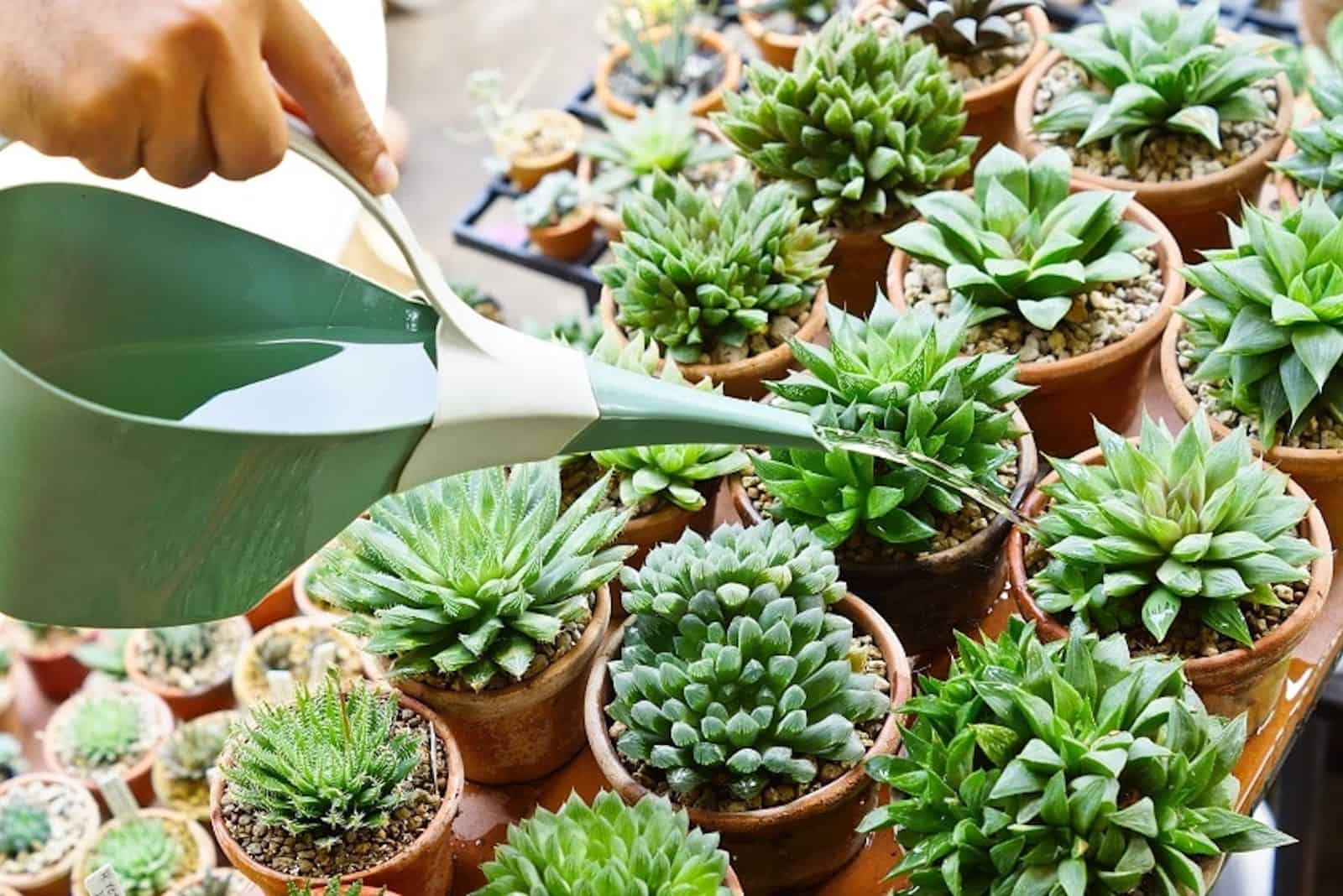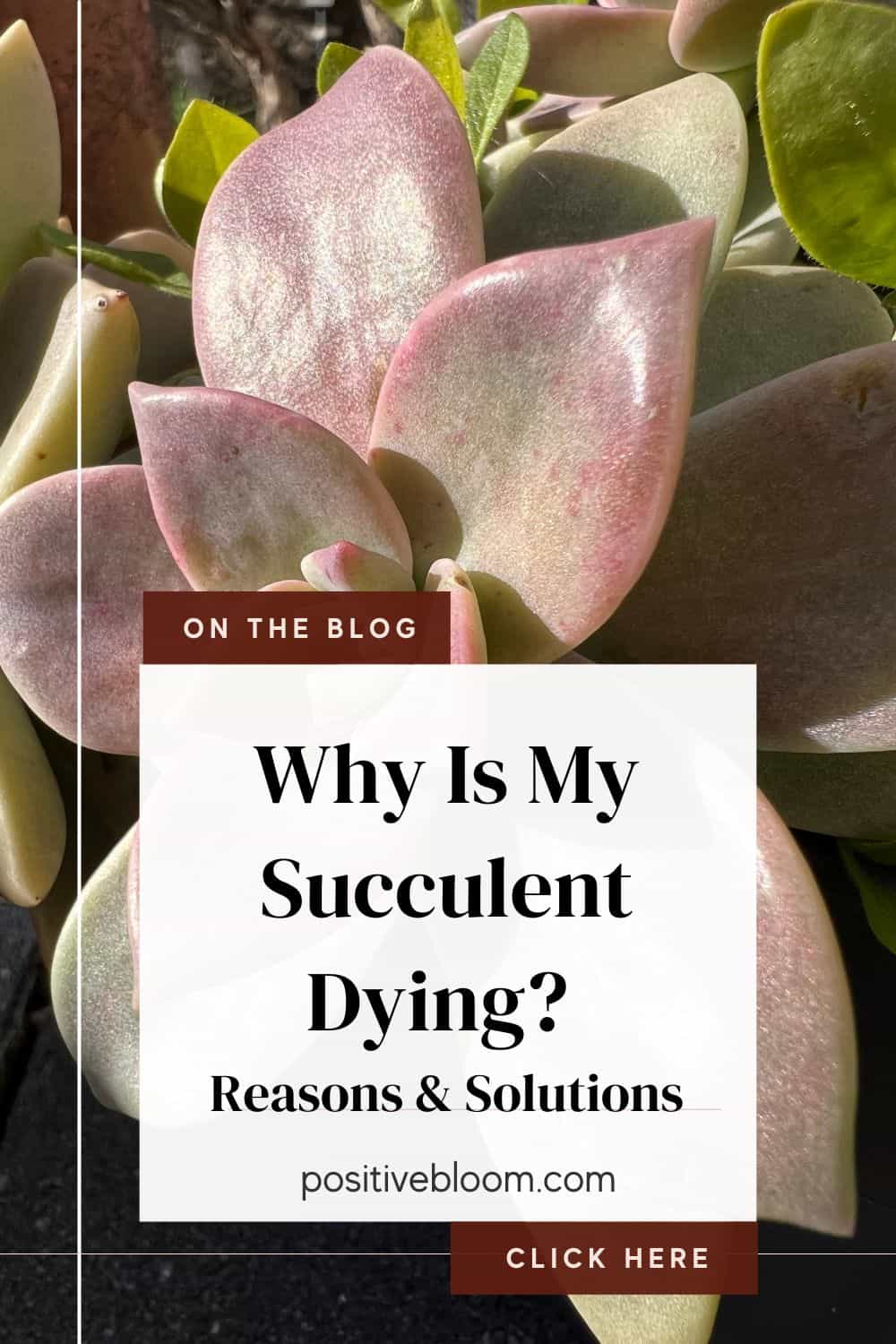Gardeners often turn to succulents and cactus plants if they want some brightness in their lives, but don’t have enough time to devote to a needy plant.
And these species are a perfect choice because you can forget about them for a couple of weeks, and they’ll still thrive.
However, they do require minimal care, and if they don’t get it they can turn on you! You’ll see a black spot on succulents, unhealthy aloe plants, succulent leaves turning yellow, and even entirely black succulents!
At which point the question: “Why is my succulent dying?” is raised.
And it’s because…
Why Is My Succulent Dying: Reasons And Solutions
The most common reasons succulent plants die are inadequate watering, lighting, fertilization, temperatures, and small pots. However, a small percentage of your fleshy-leaved plants might start withering due to natural causes and old age.
The good news is that you can prevent all these issues with just a little bit of care. So, even if your succulent starts exhibiting some of the symptoms described below, you’ll know exactly what to do to bring it back to life!
1. Overwatering And Root Rot
Overwatering is one of the most common reasons houseplants die. Too much water in itself isn’t a problem, but it can lead to root rot and stem rot, which may kill your plant.
For instance, signs of overwatered aloe plants (or any other succulent, for that matter) include leaf discoloration and a mushy texture.
Therefore, if your indoor plant has an unhealthy yellow, brown, or even black leaf color, you’ll know that your green buddy has been infected with root rot.
Other common signs of this fungal disease include stunted growth and a droopy appearance (this is especially common in plants from the Crassula genus), although you might not notice these symptoms at first on your succulents.
The causes of overwatering and root rot are watering plants too often, growing them in soils that retain too much moisture, or in pots that don’t have good drainage.
How To Revive An Overwatered Succulent
To revive an overwatered succulent, you need to reduce the watering frequency and irrigate them only when the potting mix dries out.
If you notice mushy leaves and an unpleasant smell coming from the pot, that means your green friend has root rot! In that case, you need to take it out of its container, clean the roots, and cut away all the diseased parts.
Once you finish, you can spray some fungicide on the remaining roots to prevent the diseases from coming back and repot it into fresh succulent soil with perlite.
Use a terracotta pot with drainage holes to make sure that the excess water leaves the container quickly and prevents the wet soil from hurting your plant again.
Unfortunately, if the root rot is far advanced and has infected the stem, you won’t be able to save it, although you can try to find healthy parts for propagation and start anew.
2. Underwatering
Even though succulents are drought-resistant plants, they still need some moisture from time to time. If you forget to water them, you may notice shriveled-up leaves, wilting, and an overall wrinkled appearance.
These symptoms usually occur because we don’t use enough water when irrigating them or we do it too rarely. However, the symptoms of underwatering can be intensified by porous soil, exposure to direct sunlight, and high temperatures.
How To Revive An Underwatered Succulent
If the surface of the soil is really dry, it’s highly likely that it will repel water rather than absorb it.
Therefore, you should place your potted plant in a tray filled with water so that the bottom of your succulent can get hydrated. Leave it there for about 10-20 minutes or until you can feel that the growing medium is slightly moist.
But if you want to avoid this issue altogether, you can simply water your plant thoroughly until you see the excess water draining out through the potholes.
You should irrigate your succulents twice a month, but you can increase the frequency during hotter periods. Therefore, always check the soil at the bottom of the plant (through the pothole) and start watering succulents only when it’s dry.
And lastly, never irrigate your succulent from the top of the plant since it can lead to rotting and stains.
3. Excess Sunlight
Many beginner growers associate succulents with desert plants, so they keep them in direct sunlight during the hottest parts of the day.
However, too much light can lead to sunburn and leave your precious plant with brown and even dead leaves.
Dealing With Excess Light
Unfortunately, if light damages your succulent foliage, you will have to prune it because it won’t turn green again. But if you catch this issue early, your plant can recover incredibly easily and quickly!
Then, all you need to do is study the succulent care guide for the particular variety you have and either place it in indirect light or expose it to the morning or late afternoon direct sunlight.
4. Not Enough Sunlight
Too much light can damage your succulent, but don’t just move it to complete darkness afterward.
If your plant doesn’t get sufficient light, it will become leggy, and the leaves at the base of the plant might start dying. (One of the most common reasons for the hen and chick plant dying is inadequate lighting.)
The new leaves try to perform their function, but lack of sunlight prevents it, so they become pale and yellow until they eventually die.
Managing Lack Of Sunlight For Your Echeveria And Other Succulents
If you notice pale leaves and leggy growth on your hen and chick plant (echeveria), you should move it to bright indirect light.
But do it gradually so that you don’t burn it. For instance, take your succulent to a spot with indirect sunlight and leave it there for a couple of hours before moving it back to its usual position.
Do this every day for a week or two, gradually increasing the amount of time your plant spends in the light until it can last the entire day in its new location.
Unfortunately, more sunlight won’t make your succulent less leggy or give back the color to its yellow leaves, so you’ll have to prune those parts to make room for new growth.
5. Overfertilization
Plant care for succulents includes using diluted fertilizers specialized for these species, and if we don’t follow the instructions on the package, it is very easy to overfeed them.
Too much fertilizer in the soil can lead to fertilizer burn on the roots and leaf edges, wilting, and stunted growth.
Damaged roots won’t be able to absorb moisture and nutrients from the soil, and your plant will eventually collapse and die.
Also, overfertilization can increase the risk of fungal diseases and pest infestations.
How To Revive An Overfertilized Succulent Plant
If you notice the symptoms of overfertilization, you should immediately repot your succulent into fresh soil and stop feeding it for a while.
Ready-made potting mixes usually contain enough nutrients to feed your succulents for a few months, so you shouldn’t fertilize them.
If you don’t have fresh soil at hand, you can always flush the old one. Slowly pour water into the growing medium and let it seep through the drainage holes. Use four times more water than the volume of the pot, and the old substrate will be as good as new.
6. Nutrient Deficiency
Even though succulent needs for additional nutrients are low, that doesn’t mean you should completely refrain from using fertilizers.
If you don’t repot these plants frequently, you should feed them from time to time because they can deplete the soil of the nutrients they need for healthy growth.
Common symptoms that indicate your plant could use more fertilizers are leaf discoloration (yellow if they lack nitrogen, reddish shades from phosphorus deficiency), stunted growth, smaller foliage, and a deformed appearance.
These are just some general signs because every deficiency has a particular symptom, so always look into the matter further before doing anything.
How To Treat Nutrient Deficiency In Succulents
The best way to avoid nutrient deficiency in succulents is to follow the care guide for ogre ear succulents, zebra plants, aloe vera, or any other succulent you have.
In them, you will find detailed descriptions and tips on how you should feed your plants.
Thankfully, there are fertilizers specially made for succulents that will meet their every need, but you should dilute them before use since they are highly concentrated.
Also, if you’ve determined which nutrients your plant lacks, you can use fertilizers rich in those minerals for the next 1-2 feedings.
7. Temperature Fluctuations
It makes sense that warmth-loving desert plants would be affected by sudden temperature fluctuations, especially if they plummet beyond control.
Most succulents thrive in temperatures between 55-85°F, and temperatures lower than 50°F may lead to discolorations (leaves and stems turning brown or black) and a mushy texture.
Sudden temperature swings can also stress the growth of your succulents, resulting in droopiness and failure to produce flowers.
Avoiding Temperature Fluctuations
Thankfully, it takes a long time for a plant to die because of temperature stress, and they can recover pretty quickly.
In order to avoid temperature swings, keep your succulents away from drafty windows, doors, AC vents, and heaters because the temperature quickly changes in these spots.
If you’re growing these beauties outside, make sure to protect them from sudden gusts of wind.
8. Small Pot
It might not seem to make much sense that small pots can kill your succulents, but it can happen. If your plant becomes root bound, it won’t be able to absorb the moisture and nutrients it needs to develop.
Rootbound succulents usually have yellow foliage and exhibit slow or stunted growth; they start wilting due to lack of water and even become more susceptible to pest infestations.
Repotting Succulents
Have you ever seen pictures of all those amazing haworthia types in pots that seem too large for them? Well, they’re actually the right size!
When repotting succulents, make sure that their pot is at least two times deeper than the plant’s roots and three times wider, which will provide enough room for their growth.
You should also choose terracotta pots with drainage holes since they provide optimal porosity. Plastic containers retain too much moisture and don’t have enough air circulation, which increases the risk of overwatering and root rot.
Here is a video with three simple ways for repotting succulents:
9. Natural Causes
The bottom leaves will sometimes start dying to make more room for new growth. There’s nothing you can do to prevent this aside from pruning them and speeding up the process.
Finally, certain succulent varieties, such as echeveria cultivars, can only live for a couple of years. However, they send out many shoots that will develop into new plants, so you won’t have to buy new ones.
The main plant dies, and you can’t do anything about it, but you can take care of new growth and ensure it sends many shoots in the future!
How To Save A Dying Succulent Or Cactus Plant
If you notice that your succulent or cactus has become pale, yellow, brown, or black, has started wilting and drooping, and its growth has slowed down, you should immediately try and find the cause.
But if you’re not sure about the reason, there are still some things you can do.
If you want to save a dying succulent, repot it in a new terracotta pot with drainage holes, remove all diseased parts, and use a fresh growing medium. Stick to well-drained soil with a lot of perlite and sand, which make it porous and perfect for succulents.
Also, make sure to water these plants only when the soil is completely dry, and try not to wet their foliage since that can lead to leaf spot and powdery mildew.
Fertilize them 1-2 times per month during their growing season with a succulent plant food diluted to at least half-strength.
Finally, ensure that the temperatures never drop below 55°F because repotting is stressful enough!
FAQ
We discussed the nine leading causes of dying succulents, but there are some other things we should mention, such as the best watering technique and the best types of succulents for beginners.
Those are also the things you’ve frequently asked us, so we’ll answer them in the following sections.
What is the best way to water a succulent?
The best way to moisturize your succulent plants is to let their growing medium dry out entirely and then water them thoroughly.
You can water them at the base of the plant until you notice that the moisture has started to drain through the drainage holes.
Another excellent method is bottom watering. All you need is a succulent planted in a container with at least one pothole and a larger tray.
Fill the tray with 1-2 inches of water, place your potted plant in it, and leave it there for about 10-20 minutes so that it can drink. Once the topsoil feels slightly moist, you can take your plant out of the water tray.
What are the best succulents for beginners?
Some of the best succulent plants for beginners are those from the Crassula genus, such as the jade plant and ogre ear succulent, echeverias (hen and chick succulent), aloe vera, ponytail palm, snake plants, and zebra plants.
You can find many of them on the list of tall succulent types, which are perfect for all sorts of home decor.
These plants are suitable for all growers since they are incredibly easy to take care of, and all you need to remember is to provide them with enough light and water them when their soil completely dries out.
Final Thoughts
There are many reasons your succulent might die, such as too much or too little water, insufficient or excess light, overfertilization, nutrient deficiency, temperature changes, and small pots.
And sometimes your plant may start dying due to natural causes and old age.
That’s why we decided to discuss these reasons, provide you with solutions for every one of them, and help you keep your succulents happy so that you don’t have to ask yourself, “Why is my succulent dying?” ever again.
We hope you enjoyed it!
Until next time.
Like this post? Share or pin it for later!

